How to set up a freshwater aquarium with your kids
This post is sponsored by Babbleboxx.com on behalf of Mars Fishcare and the API brand
The boys have been desperate to have a pet for as long as I can remember. They’ve expressed their need to have a dog in the family and whilst I would also love nothing more, having a dog is a big responsibility, one I don’t think we’re quite ready for yet.
This got us thinking about other alternatives, something that would make a great first pet for kids, and we concluded that fish would be the ideal pet! Both Mr H and I have come from families that raised fish. My dad had a huge goldfish tank while my father-in-law had a freshwater tank for tropical fish. We’ve talked about setting up an aquarium of our own before but never got around to doing it. However, keeping fish would be a great first pet for kids as they are relatively low-maintenance and would also teach them to be responsible for them.
Studies also show that children who grow up with an aquarium do better academically too.
We were fortunate to be working with the experts over at API Fish Care to help us set up our aquarium. They have been in the industry for almost 60 years developing and creating products to help people enjoy their aquariums. I attended a virtual event with Gary Jones, Manager of Industry Relations at Mars Fishcare. He walked us through step-by-step of what we needed to set up our fish tank correctly and how to look after tropical freshwater fish.
If you are also thinking about setting an aquarium but aren’t quite sure what you will need and how to get the tank ready for fish – read on.
How to set up a freshwater aquarium
My boys were beyond excited when I told them we were going to set up a freshwater aquarium. They started researching and putting a list of the type of fish they would like in their tank. Of course, before you get to the fun part of choosing your fish, you need to make sure you set up your tank correctly and here’s how.
You will need:
- Fish tank
- Heater
- Light
- Filter
- Gravel or rocks
- Plants (can be real or plastic)
The first thing you will need to do is decide what size tank you would like.
If like us, you are a beginner then a tank between 45-65 litres would be the ideal size to start with. Tropical freshwater aquariums need to be around 24°-26° so you will need a heater to keep the water at this temperature. Aquariums also need to have a day and night cycle so having a light is also a must. Fish usually need around 8-10 hours of daylight. A filter is required to clean the water of any dirt or debris and to keep the water at the right level of ammonia and nitrates so that fish can breathe.
You will need to add a layer of gravel or rocks at the bottom of your tank. This is required to promote a healthy environment for your fish to flourish. Before adding this to the tank, wash it thoroughly until the water is clear. This will prevent the water in your tank to be cloudy.
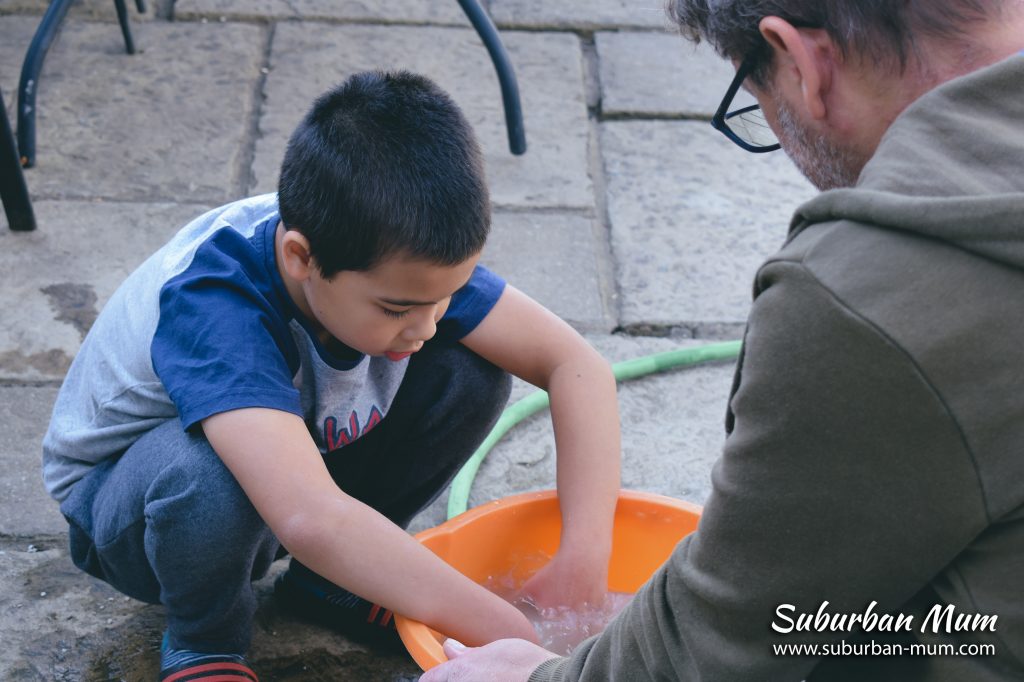
Lastly, add some plants. They can be live or plastic or even a mixture of both.
Having plants in the aquarium will give fish places to hide and explore.
Live plants will provide fish with oxygen and nutrients and can also reduce algae in your tank.
You will also need the following items to make your water fish-ready.
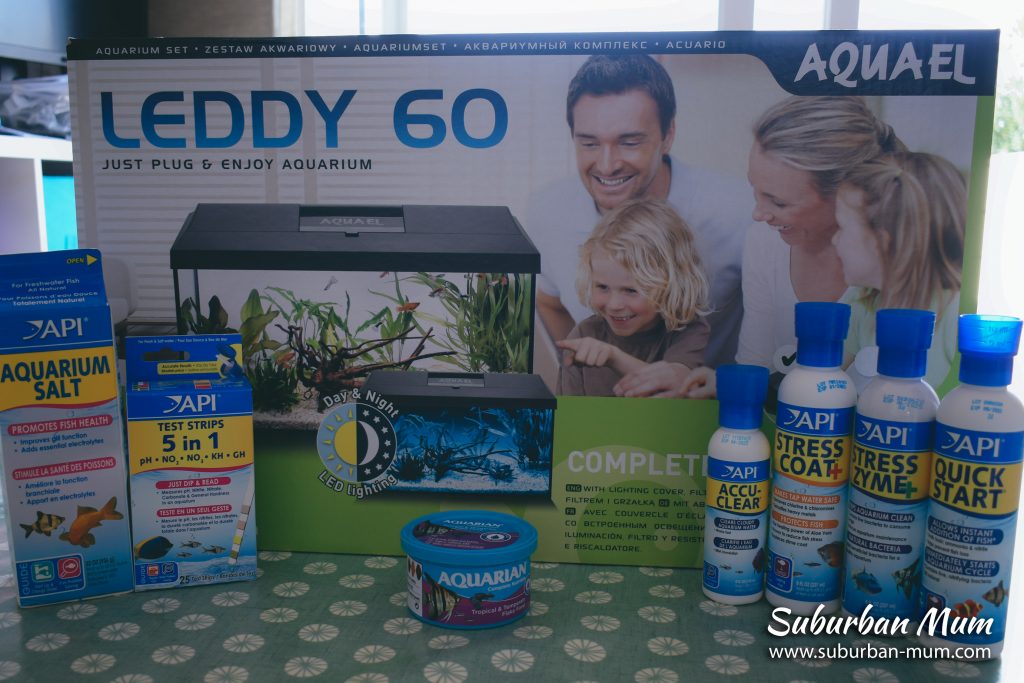
- API® Quick Start
- API® Aquarium Salt
- API® Stress Coat
- API® 5-in-1 test strips
- API® Stress Zyme
- API® Accu Clear
Setting up your aquarium
First and foremost choose where your tank will live. This is important because once you have added in the water, you will not be able to move it. We decided to buy a dedicated stand for our aquarium as we wanted it in the living room where we spend most of our downtime.
Once your aquarium is in place, add the gravel to the bottom, then the water. You will now need to treat the water to make sure it’s safe for fish to live in. We added a dose of API® Stress Coat as it’s a water conditioner that removes chlorine, chloramines and other nasties. It also contains Aloe Vera, which helps reduce fish stress which can happen when you are transferring fish from one place to another.
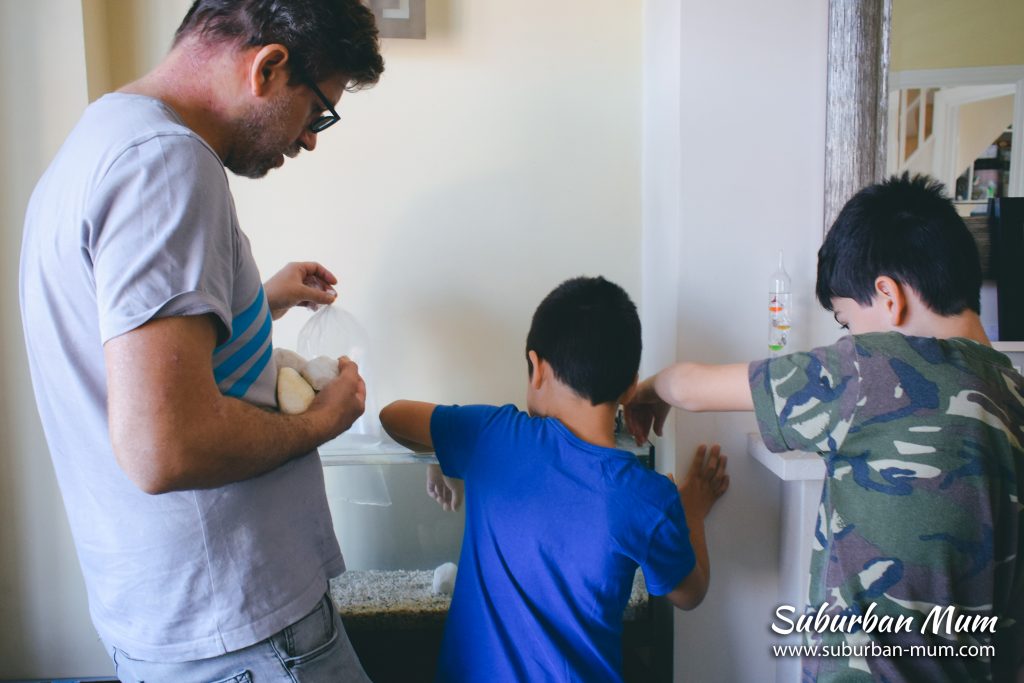
Next, we added the API® Aquarium Salt, which provides essential electrolytes that fish need to stay healthy. It also aids their health by improving gill function, which helps them breathe easier.
Finally, you will need to add a dose of API® Quick Start. This adds beneficial bacteria into the tank, immediately starting the natural aquarium cycle and converts ammonia to nitrate.
Once all the above has been added in, you will then need to use API® 5-in-1 test strips to check the levels of pH, KH, GH, Nitrite and Nitrate are correct before adding your fish into the tank. When we tested our water using the strips, both our KH and GH levels (water hardness) were not at the right level, so we mentioned this at the aquatics centre we visited. They weren’t overly concerned and said that as we lived in a hard water area, the fish are generally used to this. They recommended adding some bogwood to try and reduce the hardness of the water, but at present, this doesn’t seem to have made a difference.
There are lots of different opinions on when your tank is ready to add fish into. Some say you need to wait a few weeks; others say to wait 24-48 as the water needs to settle. By using API® products, you can add fish straight away.
Choosing your fish
Now comes the fun part which my boys were hands down the most excited about – choosing the fish. They had made a list of the types of fish they would like, and we took this along with us so we could ask the experts what fish would get along and what size fish were recommended for our 54-litre tank. We were told to start introducing fish to the tank slowly, so we came home with two Sunset Balloon Rams which the boys have named Groovy and Silver. The following week, we added four Cardinal Tetras. We plan to add a few different types each week until we have around 15-20 fish.
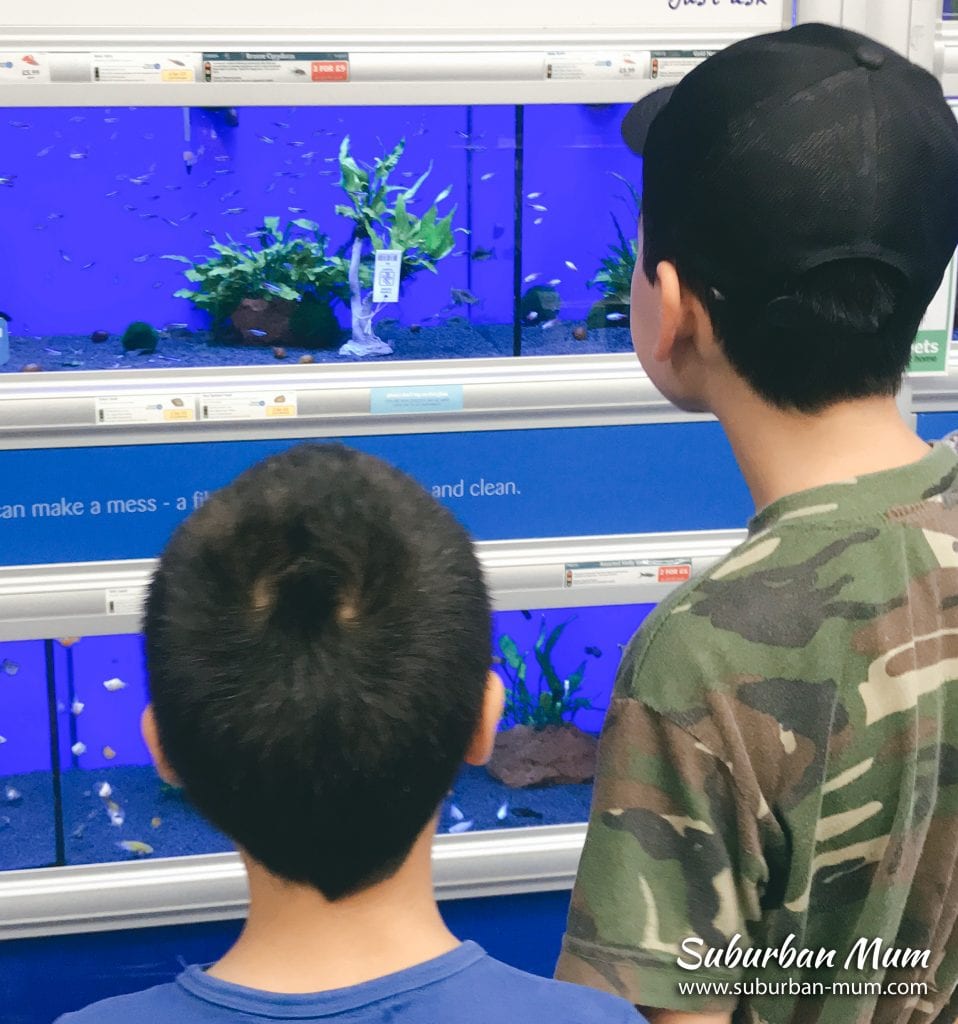
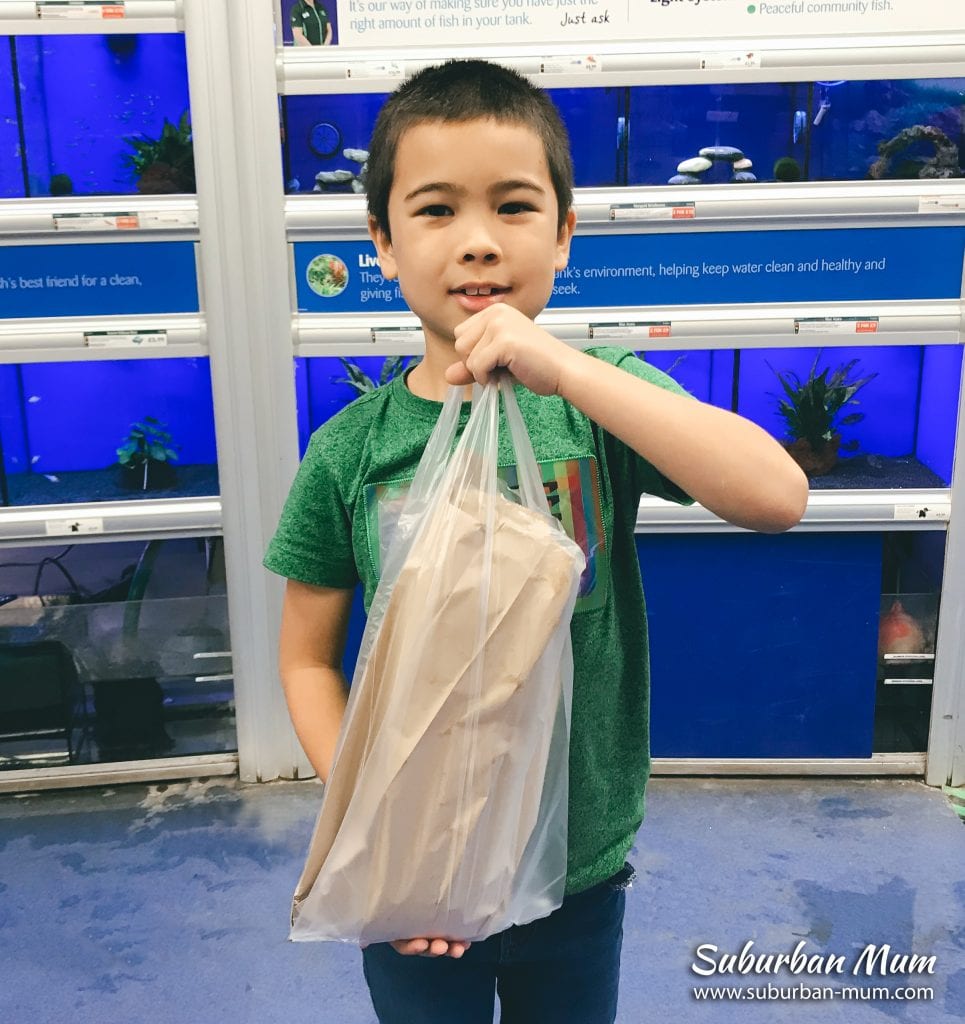
Introducing your fish to the tank
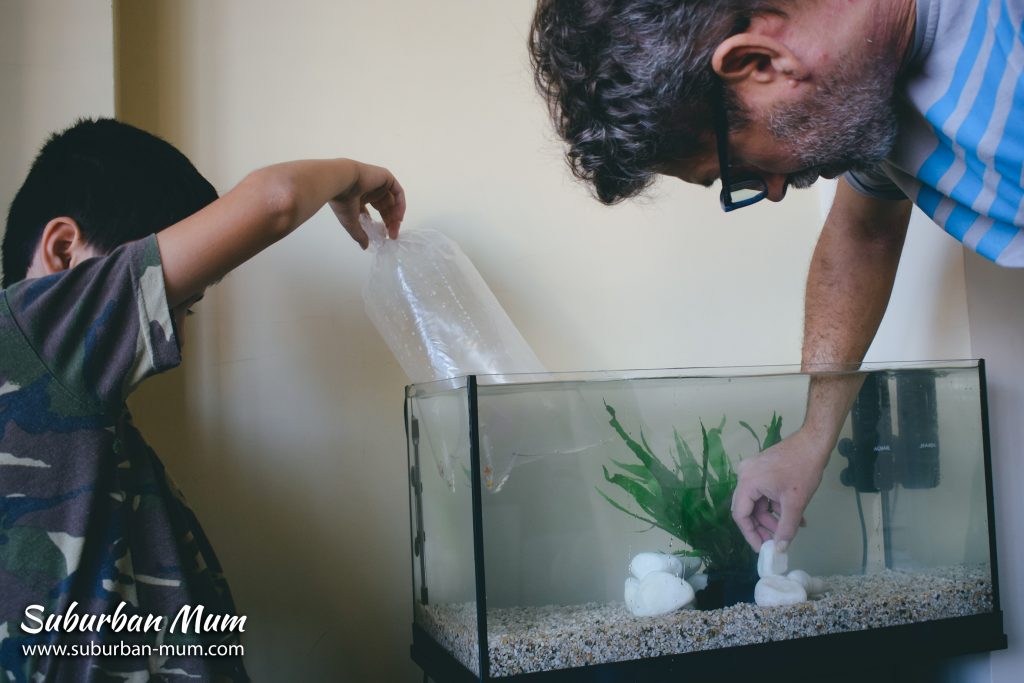
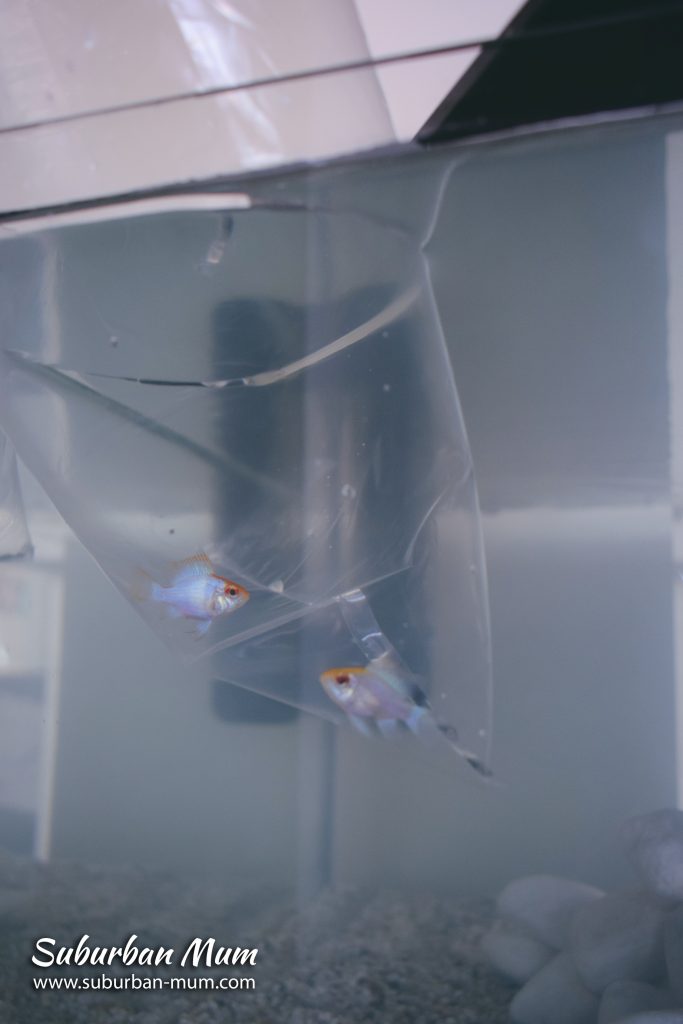
Once we bought our fish home, we had to float the fish bag into our aquarium for 45 minutes so the fish would slowly acclimatise to the temperature of our tank. After 45 minutes we opened the bag and added a cup of our aquarium water to the bag and left it for another 15 minutes. We did this one more time before letting the fish into the tank. We then added a dose of API® Stress Coat and API® Quick Start to reduce fish stress and to help them settle quickly in their new home.
The fish expert advised us not to feed the fish for 24 hours as they’re usually getting used to their new home and don’t have an appetite.
Generally, fish need to be fed small amounts twice a day. We have been using AQUARIAN Tropical Flake Food.
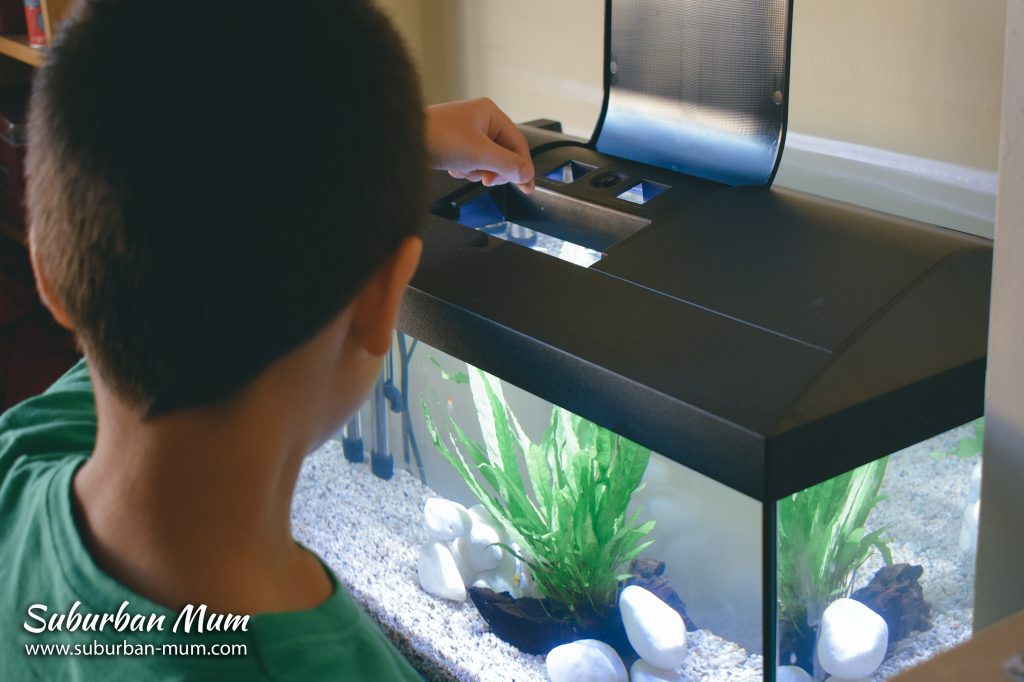
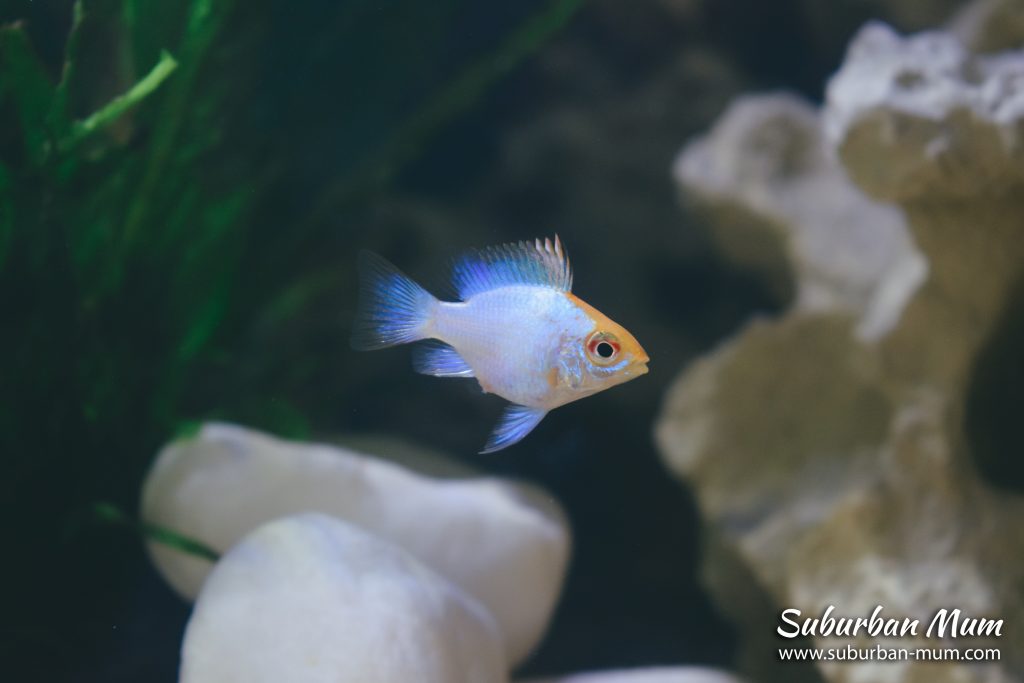
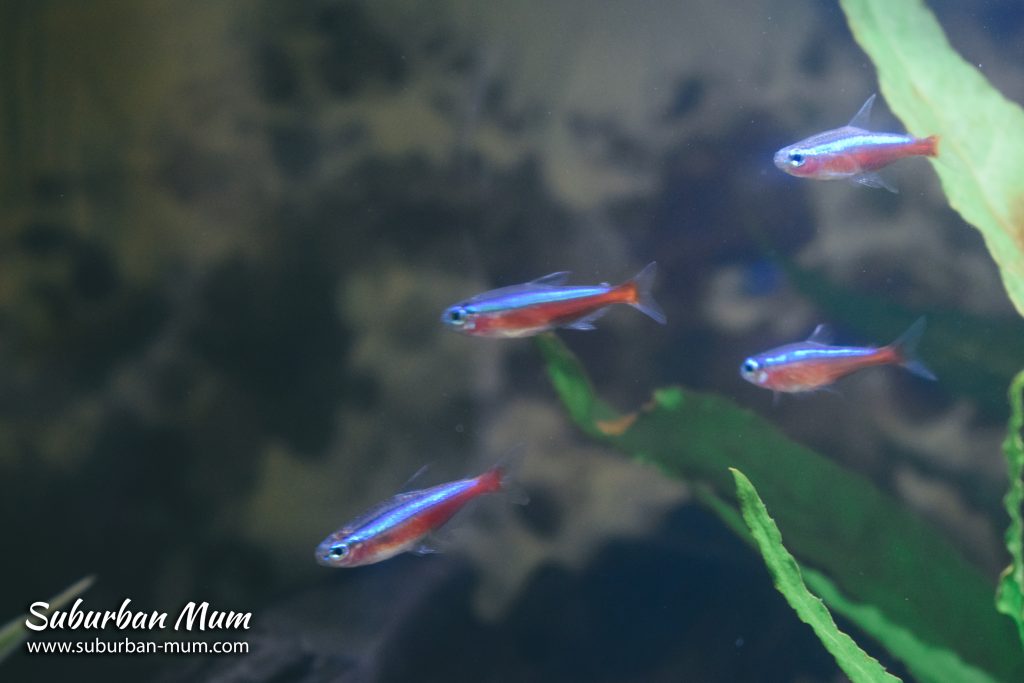
Cleaning and maintaining your tank
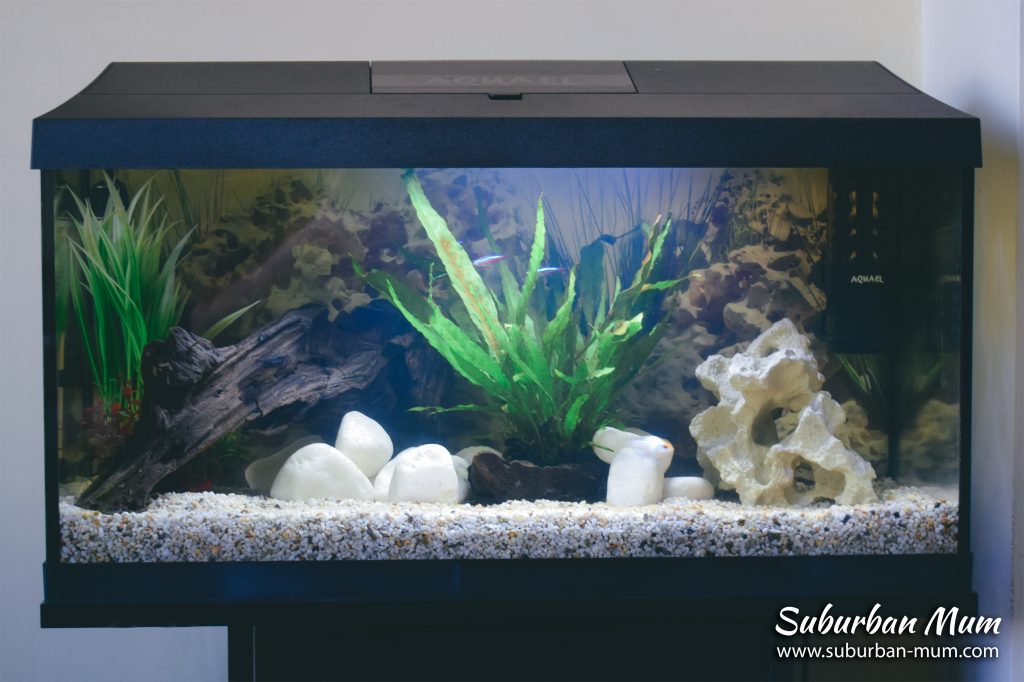
Maintaining your tank is a must if you want your fish to thrive and remain healthy. This will keep the habitat in good condition for your fish to live in.
- Clean your tank every 2-4 weeks and do a water change
- Using a hose or siphon to drain the tank down by 25% before filling it back up with water
- Add API® Stress Coat and API® Aquarium Salt to add electrolytes back into the water
- Clean the gravel with a siphon
There’s no need to remove the fish when cleaning; it’s less stressful for the fish this way. If you have issues with cloudy water or algae you can add either API® Stress Zyme and API® Accu Clear.
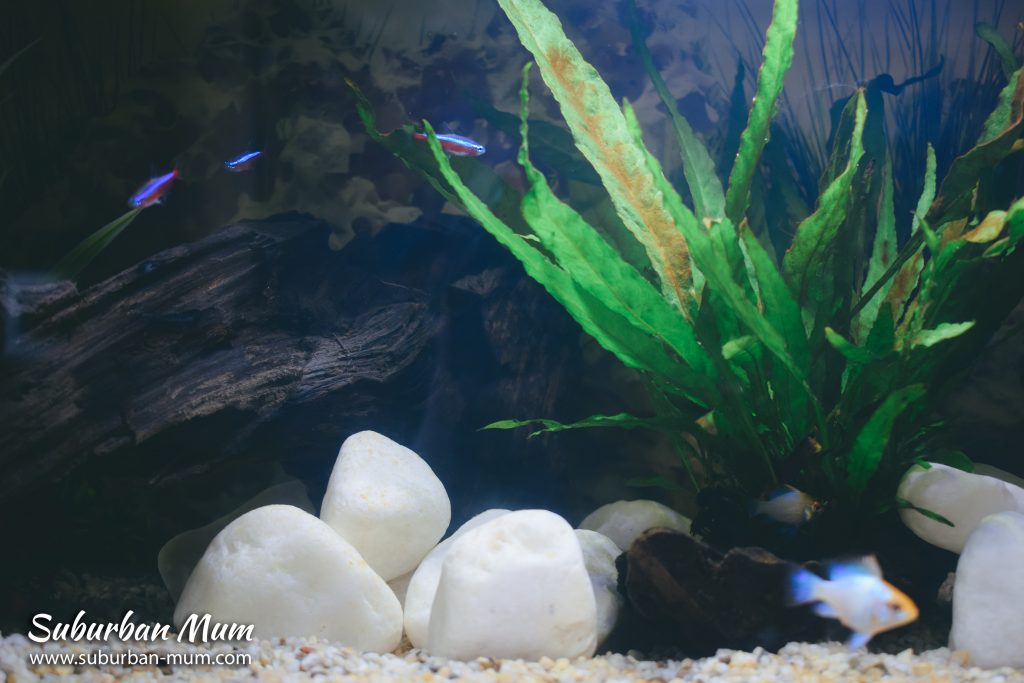
Our boys have loved having the aquarium, and as you can see from the photos, we have involved them in every part of the process. They both take it in turns to feed them morning and night and have been learning how everything works.
Thank you so much to Mars Fishcare for giving us the opportunity to set up our own freshwater tank so the boys can have their very first pets!
If you are thinking about setting up your own freshwater tank, you can find a wealth of information on how to care for your fish over at apifishcare.com
You might also like:
Pin it for later:
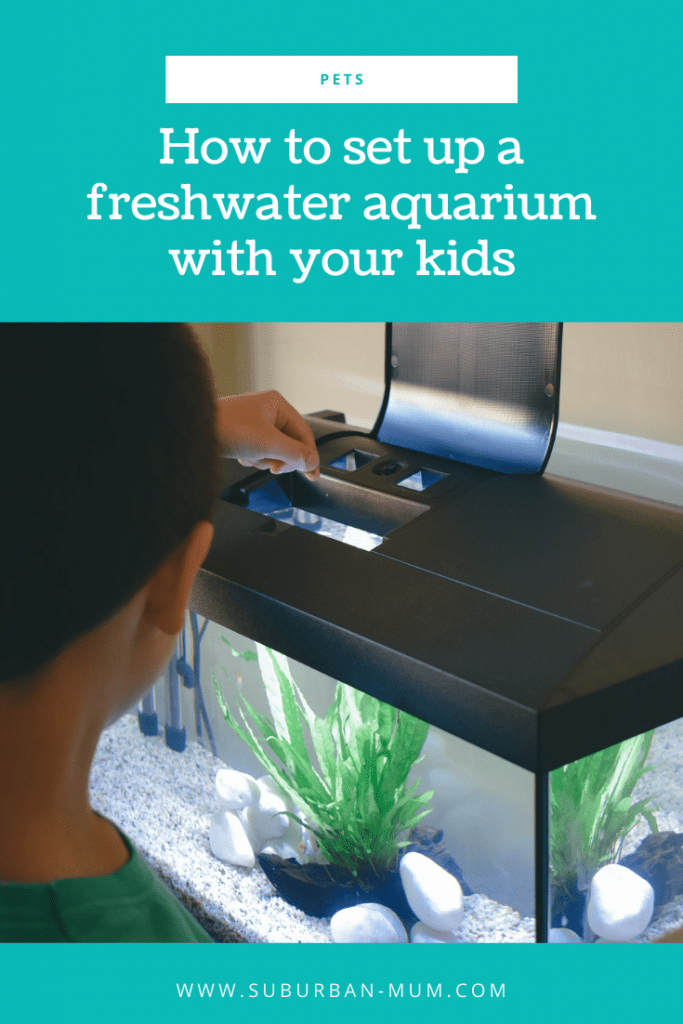

![[AD] We’re a cricket-mad family, so we’re buzzing that @thehundred is back this August! 🏏🔥
To get ready, M tried out the official FREE Activity Pack — and it’s brilliant! 🙌
Packed with fun games, creative challenges and sporty tasks, it’s perfect for getting kids hyped whether you’re at home or on the go.
👉Download yours now (link in bio)
@londonspirit @ovalinvincibles #EveryMomentCounts #TheHundred
#EnglandCricket #CricketFamily #TheHundredCricket #LondonBloggers #Cricket #CricketIsLife #kidsfun](https://suburban-mum.com/wp-content/uploads/2022/11/505472555_18531279601016840_7092520074819907569_n-180x320.jpg)



![[AD - Press visit]
We enjoyed the glorious sunshine this weekend with a trip to Brighton. We went on the @brightoni360official which is right by the sea front.
The i360 pod take a slow journey up, allowing you to take in views across Brighton and the South Downs 450ft above ground. There’s a bar inside with drinks and snacks available to purchase and the experience lasts 25 minutes.
Afterwards, we headed to the open air roller rink for a roller skating session!
The roller rink is:
⭐ Suitable for over 5s
⭐ £6.50 if you have your own skates or £9.50 if you need to hire them
⭐ 45 minutes per session
Full details to visit the i360 + skating
📍 Brighton i360, Lower Kings Road, Brighton BN1 2LN
🚗 Parking nearby (we parked in the Regency Square Car park)
🎟️ Prices start from £25.40 for an adult and £16.90 for a child
🕐 Opening hours are currently Sun-Fri 10.30am-18.30pm and until 19.30pm on Saturdays
☕️ Bar inside the i360, cafe and gift shop
Book tickets here:
https://tickets.brightoni360.co.uk/tickets/?_ga=2.195305772.1869001490.1689671753-1757164059.1689671753/#events?eventid=157](https://suburban-mum.com/wp-content/uploads/2015/04/417980235_313576471048632_3682382982231216432_n.jpg)

![[AD] ***Summer of fun at Barracudas Activity Camps!****
There is plenty for kids to do at @barracudas_activity_day_camps
From Tennis, Archery, Swimming, Motor Sports and more you can be sure that there will be something for kids aged 4.5-14. ⚽🏈🥅🎾🏓🏎️🏹🏊♂️🏉
You can book on a day by day basis - so it can fit in with any other days out/activities you have planned and there are early drop off and late pickup options available. Barracudas are also Ofsted registered so you can use your Childcare Vouchers too.
⭐⭐⭐Get £20 off a week or £4 off a day using my discount code: MARIA20⭐⭐⭐
#BarracudasActivityDayCamp #BarracudasActivityCamp #BarracudaAmbassadors #SummerHolidays #SchoolHolidays #Summer2023 #SummerCamp #DayCare #Camp #KidsCamp #surreymummy #surreymums #SummerOfFun #ActivityCamps #HolidayCamps #Childcare #SchoolHolidays #schoolholidaycamps](https://suburban-mum.com/wp-content/uploads/2024/07/353583570_625625966167953_545896259645102575_n.jpg)



![[AD] We have some super exciting news...we have been chosen to be Laser Quest Ambassadors, and the boys are over the moon!
We are really lucky that our local Laser Quest (@laserquestkingston) is just around the corner from us. It means we can pop in of a weekend or anytime during the school holidays, and with summer just around the corner, I know Laser Quest will be one of our go-to places for some family fun.
As well as games of Laser Quest, there are also VR experiences and arcade amusements too. To find out a bit more about how Laser Quest works, you can read my blog post: https://www.suburban-mum.com/laser-quest-kingston/ (clickable link in bio)
Don't forget to keep an eye out for our Laser Quest posts - I'm going to be giving away two family passes to use at Laserquest Kingston!
If you can't wait and want to head down to Laser Quest to try it out, use the code SUMMER30 for 30% off your booking. The code is valid from now until the end of August 2023 and can be used on Laser Quest games and birthday party bookings.
#LaserquestAmbassador #Laserquest #LaserquestKingston #ActivitiesForKids #FamilyFun #DaysOutWithKids #Lasertag #LaserquestVR #Kingston #ThingsToDoInKingston #SurreyFamilyDaysOut #ThingsToDoWithKids #RainyDayFun #SurreyMummy #SurreyLife #LifeWithKids #LifeWithBoys #familyfunday](https://suburban-mum.com/wp-content/uploads/2015/04/353230107_797358078406942_2405522556733455165_n.jpg)

![[AD] The sun has finally made an appearance and the boys have been making the most of it by spending it
in the garden.
They’re go-to is always football and they’ve been trying to improve their aim and accuracy with the new Messi Foldable Footlball goal from the #MessiTrainingSystem range.
I love the fact the goal is foldable, making it easy to store away when not in use. It is also lightweight so you can effortlessly pack it up and take it to the park or to a friend’s house.
The Messi Foldable Football Goal retails at £36 and can be purchased from @argos
You can read my full review here: https://www.suburban-mum.com/messi-foldable-football-goal/
#TrainLikeMessi #FoldableFootballGoal #FootballSkills #OutdoorFun #LionelMessi #LeoMessi #FootballAtHome #OutdoorKids #JustGetOutside #OutdoorsAndFree #ScreenFreeKids #WhateverTheWeatherKids @flair_gp](https://suburban-mum.com/wp-content/uploads/2024/07/341194882_615024710178056_41977149395989448_n.jpg)

![[AD] We are absolutely thrilled to announce that we are Barracuda Ambassadors again this year.
With Easter just around the corner, the boys were sent the @barracudas_activity_day_camps new camp kit in preparation for the school holidays.
There’s a wide range of activities for kids aged 4.5 - 14 including Tennis, Archery, Basketball, Arts & Crafts and more.
If you like the sound of Barracudas, find out more over on their website. You can also save £20 a week or £4 a day, using my discount code: MARIA20](https://suburban-mum.com/wp-content/uploads/2015/04/336812306_765234558514317_685553691647241974_n.jpg)


![[AD - Gifted]
Last weekend we were invited to try out @tsarettaspice’s new Bottomless Brunch menu and I can tell you it was thumbs up all round!
There’s a good choice tapas on offer from Punjabi fish fingers, Indo Chinese Chicken to Spiced Lamb Scotch Eggs and Manchurian Cauliflower (which was amazing!)
If you’re local to Twickenham and fancy giving them a try here’s are the details.
Tsaretta Spice Bottomless Brunch
⭐️£37.50 per head for bottomless Prosecco or cocktail of the day
⭐️£55 per head for bottomless Champagne
⭐️ Food included: 4 tapas selections and dessert or 2 tapas selections, a pav or naanwich and dessert
⭐️ Non-alcohol brunch is also available
Tsaretta Spice
55 Church Street
Twickenham
TW1 3NR
You can also read our full review over on the blog (link in bio)](https://suburban-mum.com/wp-content/uploads/2015/04/334565436_5960402314015030_663031098700829518_n.jpg)
![[AD] What does family look like for you?
I am fortunate to be surrounded by strong, powerful women in the form of my mum, sister and mother-in-law (along with many others). With Mother’s Day just around the corner, @BootsUK want to celebrate all the different mums and mother figures we are lucky enough to have in our lives. They have a huge range of Mother’s Day gifts to choose from so we can show them how much they mean to us. (swipe to take a look at some of my choices)
If you want to express love and appreciation for the mother figure(s) in your life, head to Boots.com to find the ideal gift. They have a whole host of gifts, so you can be sure to find something to suit all tastes. Celebrate the #LoveForAllMums this Mother’s Day with Boots.
](https://suburban-mum.com/wp-content/uploads/2024/07/334276459_136658625736352_6403224988403337253_n.jpg)

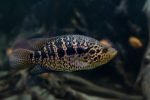


14 thoughts on “How to set up a freshwater aquarium with your kids”
Love that pic of the fish close up!! I used to love having fish but the cleaning put me off so this sounds a lot more painless!! x
We’re still early days yet but hopefully as it’s only a 25% water change every few weeks it will be relatively painless!
This is so cool and so interesting to read about! I’d forgotten, but my sister had some of those Cardinal Tetras – I loved them! Although I don’t think we knew so much about looking after them back then! :/ Love how excited the boys are; Ava has started asking to get some fish recently – a dog isn’t enough apparently!! x
We love the tetras! Hoping to get a few more when we go next. I love that Ava is asking for fish. Mine are desperate for a dog!
This aquarium looks lovely! I really think that fish are so relaxing to watch and a great way to introduce kids to the concept of having responsibility and looking after something too. We have a fish pond in the garden with koi in it, but I’d love an aquarium in the living room. #KCACOLS
They are relaxing to watch although we added a couple of corydoras and they are very energetic!
We are currently pet less and this is one of the things that I have been considering. It seems pretty low maintenance which is a pretty big plus #KCACOLS
It was relatively easy to set up and maintenance has been minimal. I would recommend it!
This looks fab! I hope they will continue to take on the responsibility of cleaning the tank. Thanks so much for linking up at #KCACOLS. Hope you come back again next time.
They’ve not been too bad so far, they take it in turns to feed them x
That looks fun! I hope the boys look after the fish well #KCACOLS
They are really enjoying it!
I find fish so relaxing to watch. The product range seems really good as cleaning the tank puts me off getting fish, the 25% method and leaving the fish makes it much easier than I thought it would be.
Katrina x
#KCACOLS
We had fish at our old house in a raised outside pond. Unfortunately they could not move house with us so they stayed with the new owners.